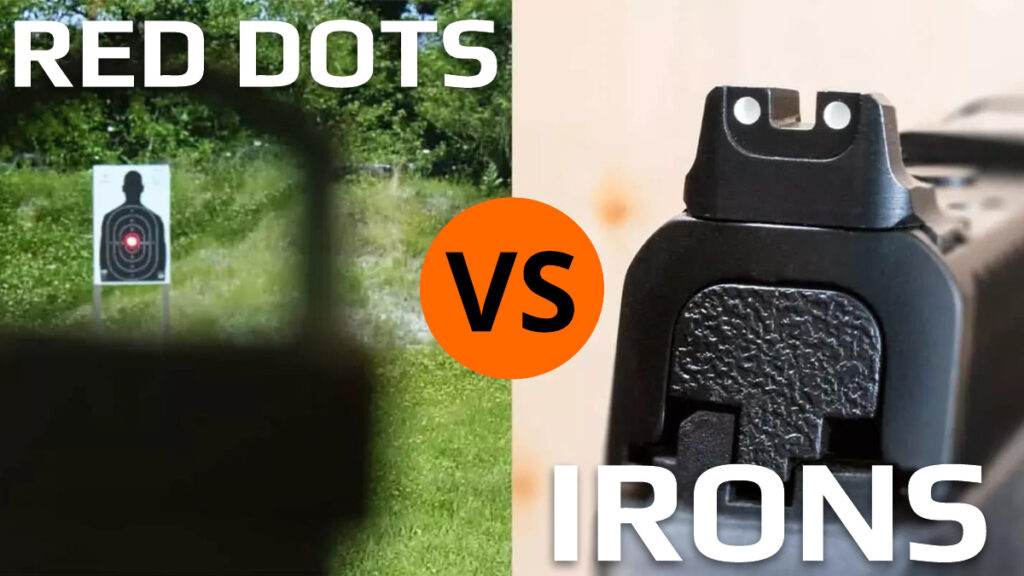There’s no arguing that the red dot optics on rifle platforms have been more popular over running iron sights alone. If you’re building or buying your first AR, red dots are often the first accessory people add to enhance their shooting experience.
You may find a few traditional, older-generation, shooters that prefer iron sights – probably because they trained with them in the military or because their first rifle had irons and that’s what they’re used to. Regardless, we’re going to discuss both sighting systems and offer some information to help you make an informed decision as to which of these sighting systems is right for you.
Iron sharpens Iron
Let’s talk about iron sights first. They never run out of power, no need for batteries or a solar panel, and you don’t have to turn them on or off. They may be fixed in the upright position or have the ability to be flipped up or down, or maybe the front is fixed and the rear is a flip-sight, and they’re almost always adjustable. There’s typically an elevation adjustment on the front sight and windage adjustment capabilities on the rear sight.
With fixed sights, you’re lining up the front and rear sights, putting the tip of the front post in the center of the peep sight in the rear – your target is sitting right on top of the front sight post. You also may have multiple rear apertures to choose from, most commonly you have two choices – either a large or small with the ability to flip back and forth. The larger one is used for closer targets and the small one is for smaller targets or targets at longer distances. Obviously, this is a multi-step process – and be aware that part of the target may be obscured by the front sight.
Batteries not included…
Now, on to the red dots. They definitely have their benefits and might replace your iron sights altogether. Red dots give you the ability to aim faster with a simple process – place the dot on the target and shoot. Yes, you may have to remember to turn your optic on or adjust the dot brightness to the environment, but you’re typically not obscuring your target in a CQB scenario.
You can, however, cover your target at longer distances, depending on what dot size you have. In this case, you may even have a reticle that has hold-over capabilities, by using the bottom of the dot or the outer ring of the reticle for a BDC (bullet drop compensator) if you have one.
Here’s something to think about as well with red dots – what dot size do you want? Most red dots are two Minute of Angle (MOA) on the low side and go up to 10 or 12 on the high side. For each MOA, you are covering approximately those many inches at 100 yards – so a 2 MOA dot will cover about 2 inches at that distance. It’s not a big deal if you’re shooting USPSA-sized targets out to two or three hundred yards – you can still hold a two MOA dot in the A-zone if you’re steady. However, if you have a large dot, you will be at a disadvantage at longer distances, but you’ll be able to pick up your dot faster at close quarters.
Let’s not forget that red dots require a power source – most of them run off of batteries. Some red dot sights also have solar backup capabilities. Although this could be considered a disadvantage, we’re used to the fact that we use a lot of battery-powered accessories in life. I replace my optic batteries about every 6 months just to be safe.
Why not both?
How about using both irons and red dot optics? Is this the best of both worlds?…maybe. Many red dot optics are designed to co-witness with iron sights so that you’ll be able to pick up your irons somewhere in that sight picture as you look through both sighting systems. Your sight picture may be a bit cluttered, but it’s not difficult to train your brain to function with a system like that…
Another way to incorporate both sighting systems is to have an offset dot or offset irons. This means that your primary sighting system is on top, and the offsets are out of the way at an angle that requires you to rotate your stock to acquire the offset sight(s).
My personal preference, if using a red dot with irons would be to keep it all in line with nothing sticking out to the side to get caught on something. I do, however, run an offset red dot in conjunction with my LPVO on my favorite AR.
Conclusion
In conclusion, there are several things to consider when deciding between a red dot and iron sights, or using a system with both types of sights. There’s a lot of information out there – so, do your research and, whatever you decide, train and learn how to use your equipment to the best of your ability… good luck!
Big Daddy Unlimited advocates strongly for Second Amendment rights because we believe that the right to keep and bear arms exists to protect all of the other God-given rights of American citizens. Become a member today to join our community of freedom-loving Americans, and let’s work together to support and defend our Second Amendment rights.

